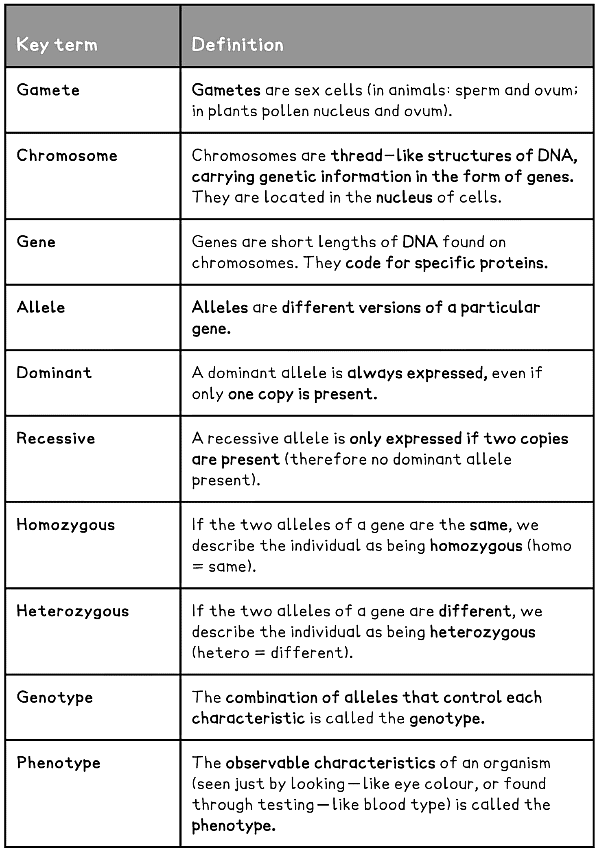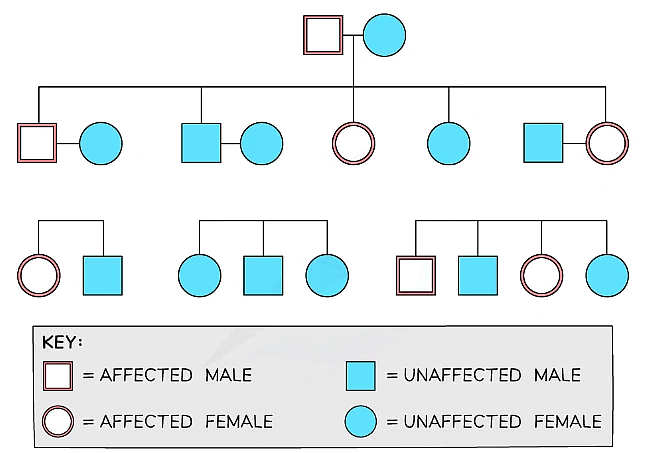Genetic Inheritance | Biology for Grade 10 PDF Download
| Table of contents |

|
| Key Terms |

|
| Monohybrid Inheritance |

|
| Multiple Gene Inheritance |

|
| Predicting Inheritance |

|
| Predicting Probability |

|
Key Terms
Table of key terms & definitions for genetic inheritance

Monohybrid Inheritance
- Some characteristics are controlled by a single gene, such as fur colour in mice; and red-green colour blindness in humans
- The inheritance of these single genes is called monohybrid inheritance (mono = one)
- As we have two copies of each chromosome, we have two copies of each gene and therefore two alleles for each gene
- One of the alleles is inherited from the mother and the other from the father
- This means that the alleles do not have to ‘say’ the same thing
- For example, an individual has two copies of the gene for eye colour but one allele could code for brown eyes and one allele could code for blue eyes
- The observable characteristics of an organism (seen just by looking – like eye colour; or found – like blood type) is called the phenotype
- The combination of alleles that control each characteristic is called the genotype
- Alleles can be dominant or recessive
- A dominant allele only needs to be inherited from one parent in order for the characteristic to show up in the phenotype
- A recessive allele needs to be inherited from both parents in order for the characteristic to show up in the phenotype.
- If there is only one recessive allele, it will remain hidden and the dominant characteristic will show
- If the two alleles of a gene are the same, we describe the individual as being homozygous (homo = same)
- An individual could be homozygous dominant (having two copies of the dominant allele), or homozygous recessive (having two copies of the recessive allele)
- If the two alleles of a gene are different, we describe the individual as being heterozygous (hetero = different)
- When completing genetic diagrams, alleles are abbreviated to single letters
- The dominant allele is given a capital letter and the recessive allele is given the same letter, but lower case
 Alleles of a gene can carry the same instructions or different instructions. You can only inherit two alleles for each gene, and they can be the same or different
Alleles of a gene can carry the same instructions or different instructions. You can only inherit two alleles for each gene, and they can be the same or different
Multiple Gene Inheritance
- Most characteristics are a result of multiple genes interacting, rather than a single gene
- Characteristics that are controlled by more than one gene are described as being polygenic
- Polygenic characteristics have phenotypes that can show a wide range of combinations in features
- The inheritance of these polygenic characteristics is called polygenic inheritance (poly = many/more than one)
- Polygenic inheritance is difficult to show using genetic diagrams because of the wide range of combinations
- An example of polygenic inheritance is eye colour – while it is true that brown eyes are dominant to blue eyes, it is not as simple as this as eye colour is controlled by several genes
- This means that there are several different phenotypes beyond brown and blue; green and hazel being two examples
Exam Tip: You will NOT be expected to explain the polygenic inheritance of characteristics using a genetic diagram, you just need to be aware that many characteristics are controlled by groups of genes and that this is known as polygenic inheritance.
Predicting Inheritance
- Monohybrid inheritance is the inheritance of characteristics controlled by a single gene
- This can be determined using a genetic diagram known as a Punnett square
- A Punnett square diagram shows the possible combinations of alleles that could be produced in the offspring
- From this, the ratio of these combinations can be worked out
- Remember the dominant allele is shown using a capital letter and the recessive allele is shown using the same letter but lower case
Example:
- The height of pea plants is controlled by a single gene that has two alleles: tall and short
- The tall allele is dominant and is shown as T
- The small allele is recessive and is shown as t
‘Show the possible allele combinations of the offspring produced when a pure breeding short plant is bred with a pure breeding tall plant’
- The term ‘pure breeding’ indicates that the individual is homozygous for that characteristic
 A pure-breeding genetic cross in pea plants
A pure-breeding genetic cross in pea plants - This shows that all the offspring will be tall
‘Show the possible allele combinations of the offspring produced when two of the offspring from the first cross are bred together’ A genetic cross diagram (F2 generation)
A genetic cross diagram (F2 generation)
- All of the offspring of the first cross have the same genotype, Tt (heterozygous), so the possible combinations of offspring bred from these are: TT (tall), Tt (tall), tt (short)
- There is more variation in this cross, with a 3:1 ratio of tall : short
- The F2 generation is produced when the offspring of the F1 generation (pure-breeding parents) are allowed to interbreed
‘Show the results of crossing a heterozygous plant with a short plant’
- The heterozygous plant will be tall with the genotype Tt
- The short plant is showing the recessive phenotype and so must be homozygous recessive – tt
- The results of this cross are as follows:
 A cross between a heterozygous plant with a short plant
A cross between a heterozygous plant with a short plant - In this cross, there is a 1:1 ratio of tall to short
How to construct Punnett squares
- Determine the parental genotypes
- Select a letter that has a clearly different lower case, for example, Aa, Bb, Dd
- Split the alleles for each parent and add them to the Punnett square around the outside
- Fill in the middle four squares of the Punnett square to work out the possible genetic combinations in the offspring
- You may be asked to comment on the ratio of different allele combinations in the offspring, calculate percentage chances of offspring showing a specific characteristic or just determine the phenotypes of the offspring
- Completing a Punnett square allows you to predict the probability of different outcomes from monohybrid crosses
Family Trees
- Family tree diagrams are usually used to trace the pattern of inheritance of a specific characteristic (usually a disease) through generations of a family
- This can be used to work out the probability that someone in the family will inherit the genetic disorder
 A family tree diagram
A family tree diagram - Males are indicated by the square shape and females are represented by circles
- Affected individuals are red and unaffected are blue
- Horizontal lines between males and females show that they have produced children (which are shown underneath each couple)
- The family pedigree above shows:
- Both males and females are affected
- Every generation has affected individuals
- There is one family group that has no affected parents or children
- The other two families have one affected parent and affected children as well
Exam Tip: You should always write the dominant allele first, followed by the recessive allele.If you are asked to use your own letters to represent the alleles in a Punnett square, try to choose a letter that is obviously different as a capital than the lower case so the examiner is not left in any doubt as to which is dominant and which is recessive.For example, C and c are not very different from each other, whereas A and a are!
Predicting Probability
Higher Tier Only
- A Punnett square diagram shows the possible combinations of alleles that could be produced in the offspring
- From this, the ratio of these combinations can be worked out
- However, you can also make predictions of the offsprings’ characteristics by calculating the probabilities of the different phenotypes that could occur
- For example, in the second genetic cross (F2 generation) that was given earlier (see above), two plants with the genotype Tt (heterozygous) were bred together
- The possible combinations of offspring bred from these two parent plants are: TT (tall), Tt (tall), tt (short
- The offspring genotypes showed a 3:1 ratio of tall : short
- Using this ratio, we can calculate the probabilities of the offspring phenotypes
- The probability of an offspring being tall is 75%
- The probability of an offspring being short is 25%
|
110 videos|93 docs|9 tests
|

|
Explore Courses for Grade 10 exam
|

|





















